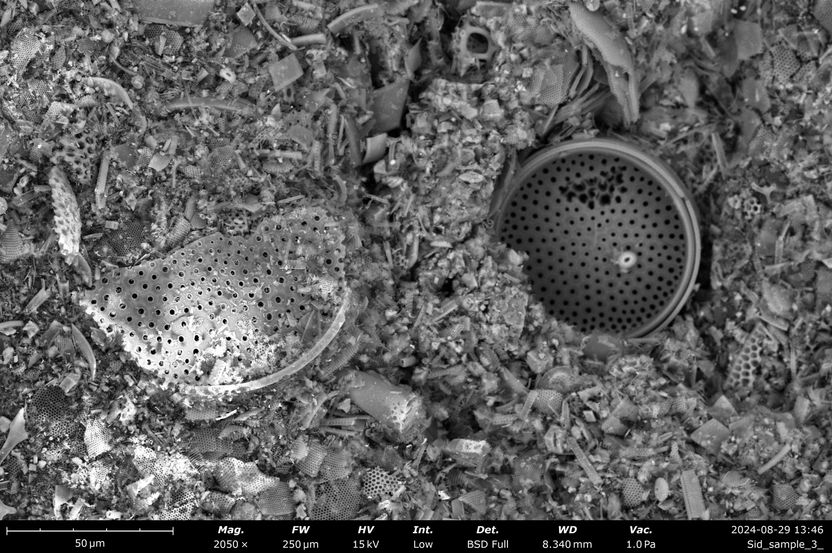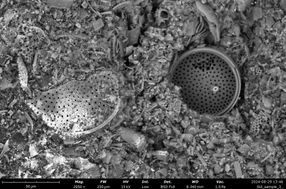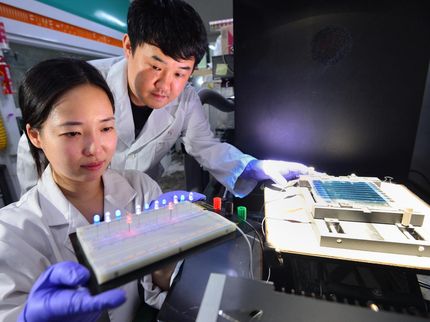Solar cells from algae
Fossil diatoms could be used to produce silicon in the future
Advertisement
The HAWK University of Applied Sciences and Arts Hildesheim/Holzminden/Göttingen is researching the suitability of fossil algae as a raw material for solar cells in cooperation with the University of Oran in Algeria. These algae are found in so-called diatomaceous earth, also known as diatomite. This is a white sedimented substance that consists largely of the shells of dead fossil diatoms. This versatile substance, which has also been mined in northern Germany since the beginning of the 19th century, is used, for example, as a material for liquid filters, thermal insulation, grinding and polishing agents, cleaning agents and insect repellents. As diatomaceous earth consists largely of silicon dioxide, scientists are currently investigating the suitability of this raw material as a base material for silicon extraction to produce the silicon semiconductors required in solar cells. In addition, researchers at HAWK and the University of Oran are analyzing the aging of the cover glasses of solar modules and the influence of environmental conditions on the chemical composition of such glasses.

Diatomaceous earth viewed through a scanning electron microscope (SEM).
Hochschule für angewandte Wissenschaft und Kunst Hildesheim/Holzminden/Göttingen

(from left) Andreas Tümmel, Prof. Dr. Christoph Gerhard, Prof. Dr. Sid Ahmed Beldjilali, Dipl.-Ing. Benny Schumacher.
Hochschule für angewandte Wissenschaft und Kunst Hildesheim/Holzminden/Göttingen


Prof. Dr. Sid Ahmed Beldjilali from the Université des Sciences et de la Technologie d'Oran Mohamed Boudiaf has now visited the Faculty of Engineering and Health at the HAWK in Göttingen for the third time as a guest researcher. After two-week research visits in October 2023 and January 2024, Prof. Beldjilali has now spent another ten days at the Faculty's Laboratory for Analytical Measurement Technology. Together with the head of the laboratory, Prof. Dr. Christoph Gerhard, and laboratory members Dr. Stanislawa Hausmann, Benny Schumacher and Andreas Tümmel, he investigated various materials used in photovoltaics to generate electrical energy from sunlight.
The Laboratoire Lasers, Plasmas et Procédés Photoniques at Aix-Marseille University, where Beldjilali and Gerhard met around ten years ago through a joint research contact, is also involved in these investigations. "I always look forward to his visit and our joint work and the associated opportunity to learn from Prof. Beldjilali's experience in the field of material analysis," says Gerhard. In addition to the close scientific collaboration, both sides also value the personal, linguistic and cultural exchange. "I enjoy every stay with my colleagues and friends in Göttingen," says Beldjilali.
Note: This article has been translated using a computer system without human intervention. LUMITOS offers these automatic translations to present a wider range of current news. Since this article has been translated with automatic translation, it is possible that it contains errors in vocabulary, syntax or grammar. The original article in German can be found here.
Original publication
Nabila Belkhir, Sid Ahmed Beldjilali, Mohamed Amine Benelmouaz, Saad Hamzaoui, Anne-Patricia Alloncle, Christoph Gerhard, Jörg Hermann; "Quantification of impurities in diatomite via sensitivity-improved calibration-free laser-induced breakdown spectroscopy"; Journal of Analytical Atomic Spectrometry, Volume 39, 2024































































